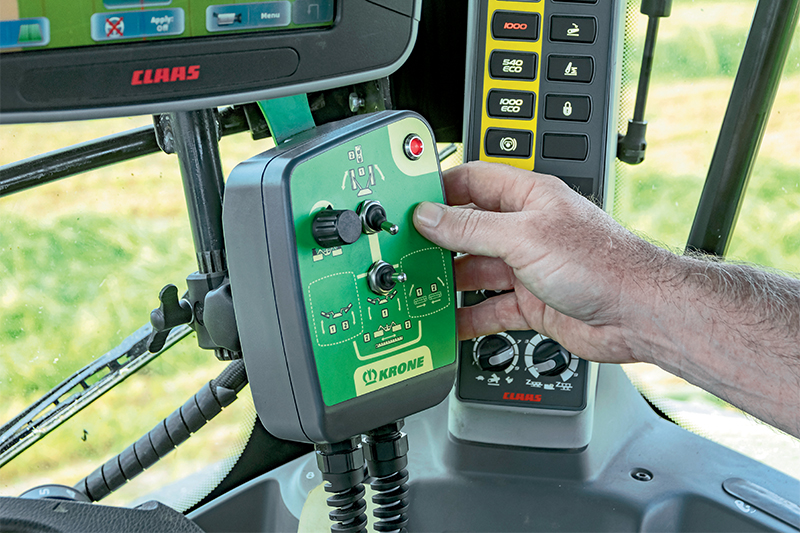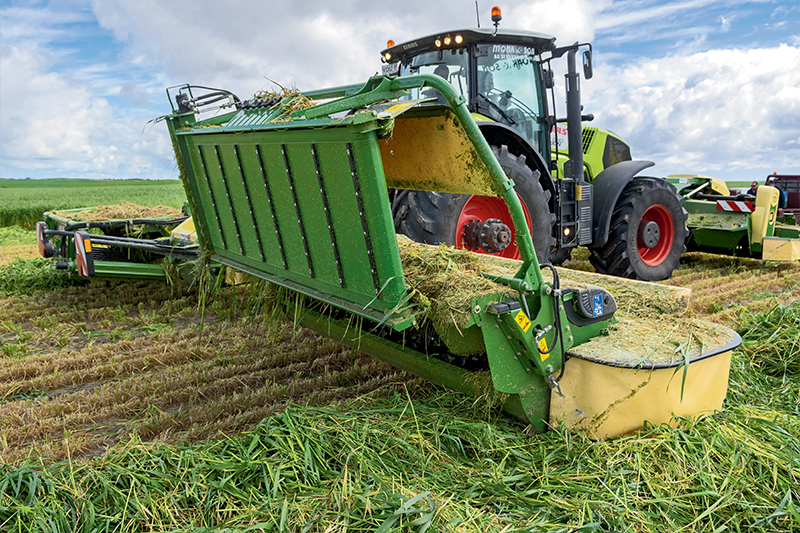It's hard to find anything negative to say about the Krone EasyCut B 1000 CV Collect and EasyCut F 360 CV mower combination, technical editor Tom Dickson reports.
A combined cutting width of up to 10.1m from a Krone EasyCut combination mower is adding up to improved economics, increased efficiency and better customer service for a south-west Victorian agricultural contractor.
Monk and Son Agricultural Services director Sam Monk uses a Krone EasyCut F 360 CV as a front-mounted mower, with a butterfly type folding Krone EasyCut B 1000 CV Collect mower at the rear. The mowers have impact protection on each individual disc and a steel tine flail conditioner, plus both rear mowers have a collecting platform which conveys the freshly cut crop into a central windrow behind the tractor.
A cut above
Sam Monk is an inspirational young bloke eager to make a name for himself in the world of agricultural contracting and, if what he has achieved so far is any indication, he is well on his way.
He is only 23 years old and has already put together a list of equipment most contractors twice his age would be envious of: tractors, mowers, rakes, balers, silage choppers, wagons, offset discs, drills and numerous other vehicles and tools. During his peak operation periods, he has up to 15 employees on his books.
What impresses me most about him are his organisational skills, relentless work ethic and mature approach to running and growing a successful business. Monk says he believes there are three key elements to providing a quality service.
“I always make sure I put the customer first and work whatever hours are required in an attempt to deliver on time – plus trust and confidentiality are a must,” he says. “I only employ workers that have the same passion for the job as I do, and I’m confident that if anything happened to me, any one of them could take control of the operation in my absence.”
“I always put quality ahead of price when it comes to purchasing equipment, making sure I have the right machine for the job.” Which brings me to why we are here.
Right machine for the job
Monk and Son Agricultural Services recently picked up the contract to transform a 200-hectare oat crop into chopped silage on Telopea Downs at Kaniva in Victoria, near the South Australian border. Telopea Downs is a 47,677-hectare property owned by Hassad Australia. Its primary purpose is to act as a sheep-breeding hub, hence the need for high-quality feed reserves – and plenty of it.
There were a few factors for Monk to consider when taking on this job. Firstly, it’s a long way from his base in south-west Victoria, so he needs to keep to a minimum the number of machines he has to transport to get the job done in the most efficient manner. Secondly, the soil at Telopea Downs is virtually pure sand, so it is important he uses a technique that will keep as much sand as possible from being picked up and mixed in with the silage in the pit.
The Krone combination mower ticked all the boxes for this job, and Monk felt confident it would handle anything he was going to throw at it. He would have normally sent up three mowers on three tractors with three drivers, but using a Krone EasyCut combination he only has the running cost of one mower, one tractor and one driver to knock down the crop.
He says the 225hp Claas Axion 830 is burning through about 27 litres of fuel per hour, but is still heaps more cost effective than running three tractors with mowers to complete the same job. They are the sort of cost savings that can be passed onto the customer, he says.
“We are pushing the tractor to its absolute maximum at 1000 PTO revs, just to maintain a speed of between 7-9km/h,” Monk says. “In normal pasture hay and silage situations I’m sure that we will have ample power, but for this particular job a few more horsepower would be handy because I reckon the mower could easily handle it.”
 |
|
The Krone control unit manages transport, headland and work positions as well as downward pressure on the mowers. Each mower can be adjusted individually.
|
Tough cutter
So that’s the economics, but there is so much more to the Krone combination mower. Impact protection and a steel tine conditioner suggest it will be able to withstand the inevitable bumps and bruises that occur throughout the season.
Monk said Krone’s unique impact protection was a major reason why he looked at in the first place: “It will save me valuable time and money because, from past experience, the more the farmer reassures me that there are no rocks on the paddock the surer you can be that you will find one.”
Shear bolt impact protection is built into each individual disc. When the shear bolt breaks, it immediately stops drive to the disc and causes the disc assembly to rise up on the drive shaft so it doesn’t clash with the adjacent discs and cause further damage. Drive is restored by winding the disc housing back down the shaft and replacing the shear pin.
Normally replacing blades can be a time-consuming task, but the quick-change blade design reduces the time dramatically. Using the specially designed tool included with the mower to open up the blade holder, the double-sided blade can be either rotated or replaced within seconds.
The CV conditioners that are used on the EasyCut B 1000 CV mowers are a flail type conditioner using V-tines made of hardened steel. Top plates above each conditioner can be manually adjusted through seven different settings. Reducing the gap between the top plates and the tines increases the degree of conditioning.
Each conditioner has a mechanical two speed gear box to provide either 900rpm for intensive treatment or 600rpm for less intensive conditioning. This extremely heavy oat crop needs maximum conditioning, and I suspect this is where a huge amount of the tractor’s available horsepower is being consumed.
 |
|
When the belts are raised the material is left spread across the full working width.
|
Flail vs roller
Many in the industry will tell you that a roller conditioner is better in pasture hay because it is less inclined to damage the soft leaf of the plant. Monk consciously opted for the flail mower because it can handle the odd rock better than a roller conditioner. Clearly there is not much chance of coming across rocks in the sandy soils of Telopea Downs, but the risk rises dramatically in other parts of Victoria where it will also be used.
The rear collecting conveyers are a standout feature. They are driven by an independent hydraulic system that runs off the tractor’s PTO, which draws less horsepower than using the tractor’s hydraulic system. The hydraulic equipment sits centrally between the two rear mowers and under a protective cover. An oil cooler protects the system from overheating.
With the collect conveyors in the up position, the material spreads evenly across the mown area. But when engaging them in the down position, they collect the material as it is flung from the conditioner and move it across and dump it into the centre to form one single windrow from a 10m cut.
A manually operated dial on the conveyer’s hydraulic system alters the speed at which the belts travel. By adjusting the belt speed, as well as the height of the accelerator rollers at the end of each conveyer, you can fine-tune the width of the windrow to match the following pickup machine.
The sandy soils mentioned previously also prompted Monk into buying a collect-type mower because it cuts out the process of raking. Raking, in sandy soils, drags in a lot of sand which promotes wear on the choppers and wagons, and contaminates the silage in the pit.
The mowers have a variable operating width of between 9.3m and 10.1m. Double acting rams inside the mower arms extend and retract the arms on the move to vary the degree of overlap. This is done from inside the cabin via the tractor’s hydraulics.
The mower arms on the EasyCut B1000 CV mowers extend and retract like telescopes. When cutting in straight lines, the arms can be extended fully for minimum overlap. On the other hand, if there are lots of curves, it’s best to bring the mowers in to produce a bigger overlap and prevent missing bits.
On this job we have to retract the mower arms completely in and have the conveyor belts running flat out to have any hope of getting the huge volume of crop into a narrow enough windrow for the chopper to pick up. In a lighter crop, the belts on the conveyor would be able to throw it further.
 |
|
Setting the headland turning height guarantees the mowers lift well clear of the crop.
|
Floats like a butterfly
The mowers appear to float across the surface on a cushion of air thanks to the Combi Float suspension system – a feature for which Krone won an award last year at AgriTechnica, Germany’s premier machinery field days.
Downward pressure can be applied to the front mower via a manually adjusted suspension system, and the rear mowers use hydraulics and an accumulator to regulate downward pressure. In the smooth sandy soil at Telopea Downs, Monk has the pressure backed right off to have the mowers just skimming the surface – but on rough, pugged ground, more downward pressure would be required to stop the mowers bouncing around.
To give an indication of how easy the mower is to operate, the basic steps are as follows. Set the conditioner speed to either 600rpm or 900rpm on the two-speed gearbox. Rotate the dial on the conveyor’s hydraulic system to achieve the desired belt speed. Set the tractor’s PTO to 1000rpm and go mowing.
An easy-to-use control box is mounted inside the cab to lift the mowers at headlands, extend and retract, fold for transport, as well as increase and decrease downward pressure. As a matter of interest, the krone combination mower has a transport width of 2.95m and height of 4m, so it doesn’t require an escort on public roads and will fit through farm gates easily.
The bottom line
After about two hours of mowing, I am struggling to find any negatives to report. The only time the Krone EasyCut B 1000 CV Collect and EasyCut F 360 CV combination didn’t put in a near-perfect performance was when we got into an area where the crop had laid down. The cut was just not quite as neat and smooth.
An experienced ear can tell that it is performing really easy and working well below its maximum output, because it is absolutely singing. You know that sweet, smooth sound of a perfectly set-up machine? It’s just music to your ears.
HITS
- Impact protection
- Quick change blades
- Rear conveyors
- Combi Float suspension with adjustable downward pressure
- Adjustable width and overlap
- Narrow transport width
MISSES
- The mower guards lay the crop down in front of the cutter bar
You can watch the full video review here.
If you’re looking for used mowers for sale, check out our listings.
Photography: Andrew Britten





